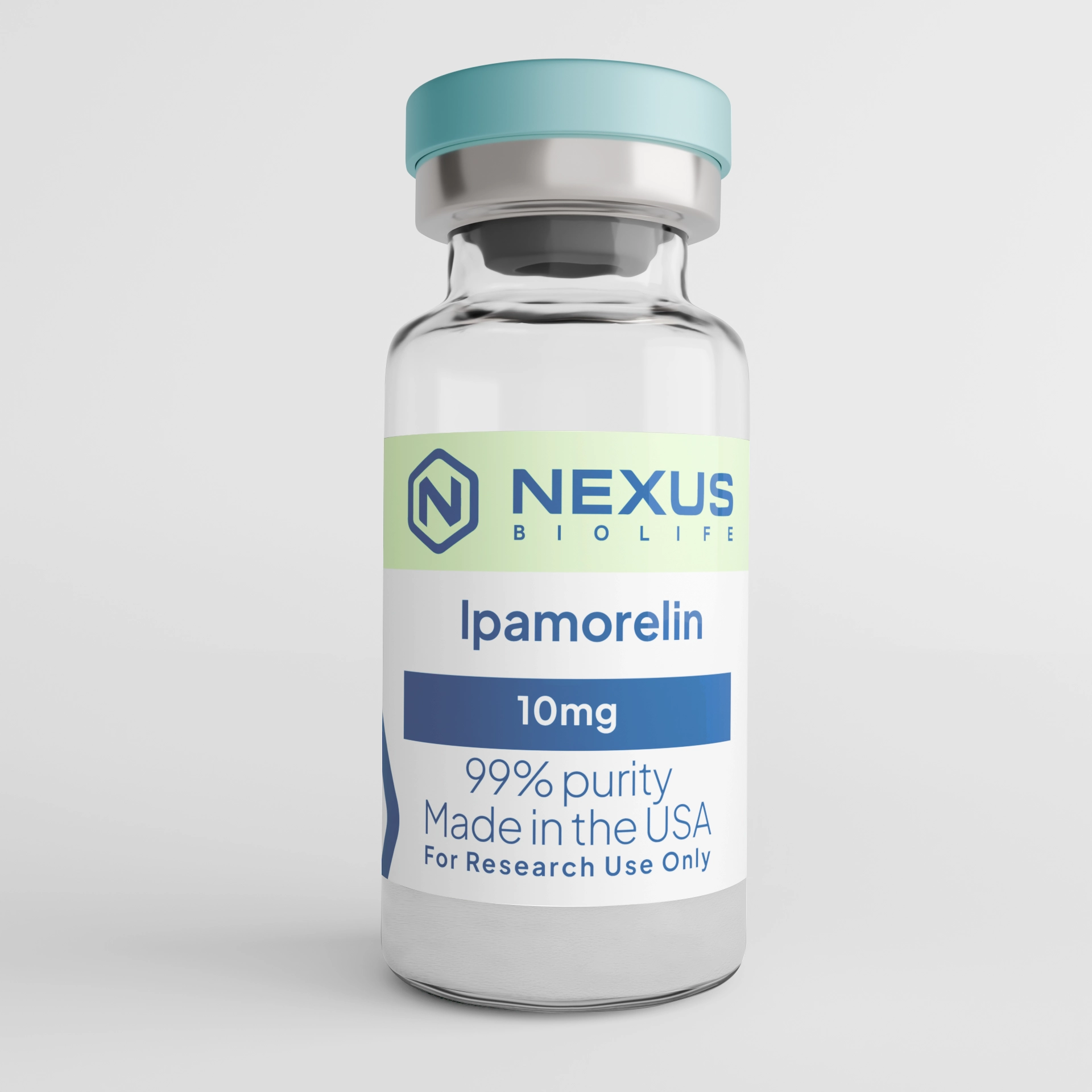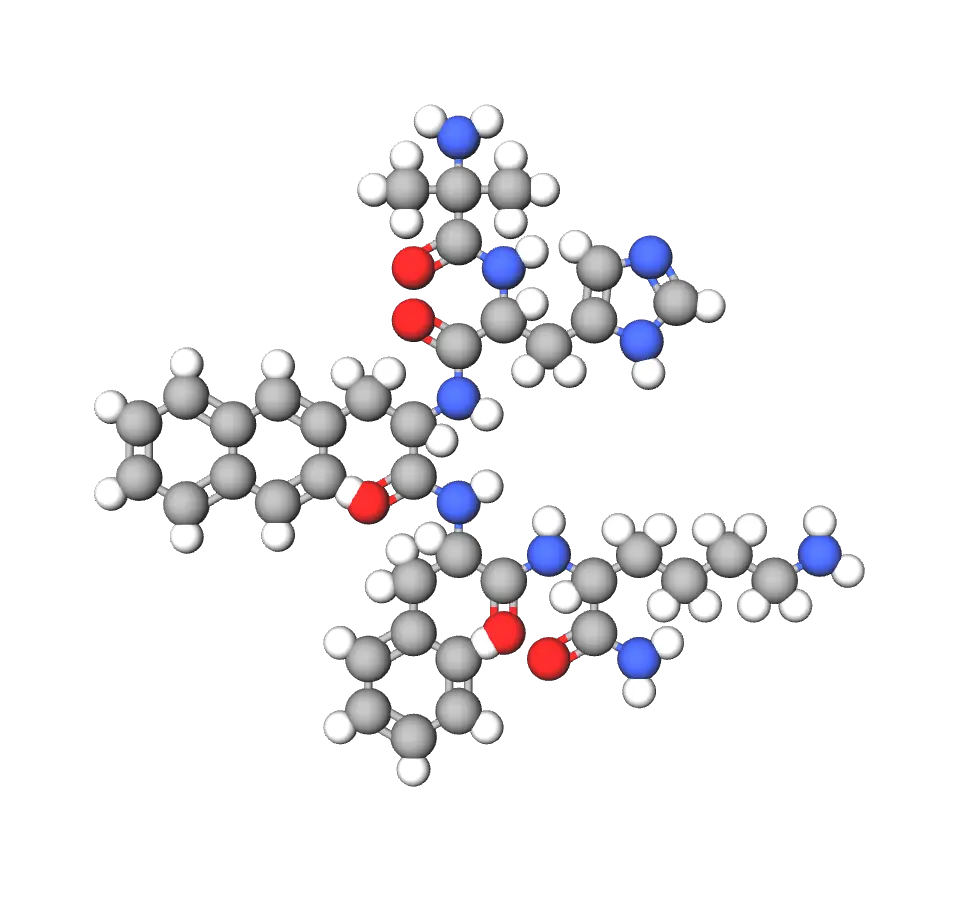
Ipamorelin is a potent peptide meticulously prepared for scientific inquiry. This product is synthesized with an impressive 99% purity. It is developed for use in various laboratory investigations. Ipamorelin is designated solely for research and development purposes.

Ipamorelin's structure is a five-amino-acid chain (Aib-His-D-2-Nal-D-Phe-Lys-NH2), with a molecular formula of C38H49N9O5 and a molecular weight of 711.868 g/mol. The inclusion of non-natural amino acids like 2-aminoisobutyric acid (Aib) and D-isomers enhances its stability and resistance to enzymatic degradation compared to native peptides, while maintaining a compact size that facilitates receptor binding. This design, lacking the Ala-Trp dipeptide found in earlier GHRPs, contributes to its selectivity and reduced propensity for off-target effects.
In laboratory settings, ipamorelin is typically provided as a white lyophilized powder with purity levels exceeding 98%, confirmed via HPLC and mass spectrometry. It shows good solubility in sterile water or neutral buffers, allowing for straightforward reconstitution in assays. Its pharmacokinetic profile includes a short half-life of approximately 2 hours, which supports pulsatile GH release patterns in models, mimicking natural secretion rhythms without prolonged systemic exposure. We prioritize transparency in our quality controls, ensuring each batch meets stringent standards for reliable experimental outcomes.
Ipamorelin is a synthetic pentapeptide and selective growth hormone secretagogue (GHS) that acts as an agonist at the ghrelin/growth hormone secretagogue receptor (GHS-R), promoting the release of growth hormone (GH) from the pituitary gland in experimental models. Derived from GHRP-1 with the amino acid sequence Aib-His-D-2-Nal-D-Phe-Lys-NH2, it exhibits high potency and efficacy in stimulating GH secretion while demonstrating minimal impact on other hormones, making it a precise tool for in-vitro research into endocrine signaling and metabolic processes. As with all our offerings, ipamorelin is supplied strictly for research purposes and in-vitro use only—not for human consumption or any clinical applications.
Ipamorelin functions by binding selectively to the GHS-R1a receptor on pituitary somatotrophs, triggering a dose-dependent release of GH through pathways that elevate intracellular calcium and possibly involve phospholipase C activation. Unlike broader-spectrum GHRPs, it does not significantly elevate ACTH, cortisol, prolactin, FSH, LH, or TSH levels, even at doses far exceeding those needed for GH stimulation, highlighting its specificity akin to GHRH. In pancreatic models, ipamorelin evokes insulin release via calcium channel modulation and adrenergic beta-receptor pathways, suggesting involvement in glucose-dependent secretion without direct impact on alpha cells.
This selective agonism results in potent GH release, with in-vitro EC50 values around 1.3 nmol/L and in-vivo ED50 of 80 nmol/kg in rat models, comparable to GHRP-6 but without the cortisol surge. Its actions may also counteract glucocorticoid-induced catabolism in muscle and bone, preserving nitrogen balance and supporting anabolic processes in stressed systems. We're passionate about clarifying these nuances—ipamorelin offers a clean probe for isolating GH pathways, free from the hormonal noise of less selective analogs.
In essence, ipamorelin emerges as a highly selective pentapeptide secretagogue, offering researchers a targeted means to investigate GH release and its downstream effects on metabolism, tissue maintenance, and endocrine balance without broad hormonal interference. Its refined profile and potent actions underscore our enthusiasm for empowering precise peptide studies with quality products and shared insights. Exclusively for in-vitro research, ipamorelin aligns with our values of transparency and education in advancing scientific exploration. Let's connect to refine your approach, one insightful experiment at a time.
Ipamorelin's specificity makes it ideal for in-vitro and ex-vivo studies exploring GH dynamics, metabolic regulation, and tissue repair. In pituitary cell cultures, it has been used to assess GH secretory potency, revealing high efficacy (Emax ~85% relative to GHRP-6) and insights into receptor-mediated signaling without confounding cortisol effects. Research in diabetic models highlights its role in insulin release from pancreatic cells, potentially via adrenergic and calcium-dependent mechanisms, aiding investigations into beta-cell function under pathological conditions.
In bone and muscle research, ipamorelin has shown promise in counteracting glucocorticoid catabolism, increasing bone mineral content and supporting nitrogen retention in steroid-treated models. It has also been probed in gastrointestinal assays for accelerating gastric emptying in postoperative ileus models, stimulating contractility through ghrelin pathways. Additional applications include endocrine disorder modeling, where its GH-selective profile helps dissect secretagogue-receptor interactions, and aging studies examining pulsatile hormone release. We support these endeavors with approachable guidance, like tips on combining it with other secretagogues for synergistic assays, always emphasizing controlled, evidence-based protocols.
For optimal performance in your experiments, store ipamorelin lyophilized powder at -20°C or below in a dry, light-protected environment to prevent degradation. Reconstitute with sterile bacteriostatic water or a neutral buffer to concentrations of 1-2 mg/mL, using gentle swirling to dissolve fully without introducing air bubbles that could affect stability. Given its short half-life, prepare fresh solutions for each assay and consider adding protease inhibitors if extended incubation is required.
Reconstituted aliquots can be kept at 2-8°C for short-term use or frozen, but minimize freeze-thaw cycles to preserve bioactivity. Our testing verifies resilience under these conditions, ensuring you can focus on your research. If handling queries arise, our team provides logical, step-by-step solutions rooted in best practices.
Ipamorelin is a synthetic pentapeptide and selective growth hormone secretagogue (GHS) that acts as an agonist at the ghrelin/growth hormone secretagogue receptor (GHS-R), promoting the release of growth hormone (GH) from the pituitary gland in experimental models. Derived from GHRP-1 with the amino acid sequence Aib-His-D-2-Nal-D-Phe-Lys-NH2, it exhibits high potency and efficacy in stimulating GH secretion while demonstrating minimal impact on other hormones, making it a precise tool for in-vitro research into endocrine signaling and metabolic processes. As with all our offerings, ipamorelin is supplied strictly for research purposes and in-vitro use only—not for human consumption or any clinical applications.
Ipamorelin functions by binding selectively to the GHS-R1a receptor on pituitary somatotrophs, triggering a dose-dependent release of GH through pathways that elevate intracellular calcium and possibly involve phospholipase C activation. Unlike broader-spectrum GHRPs, it does not significantly elevate ACTH, cortisol, prolactin, FSH, LH, or TSH levels, even at doses far exceeding those needed for GH stimulation, highlighting its specificity akin to GHRH. In pancreatic models, ipamorelin evokes insulin release via calcium channel modulation and adrenergic beta-receptor pathways, suggesting involvement in glucose-dependent secretion without direct impact on alpha cells.
This selective agonism results in potent GH release, with in-vitro EC50 values around 1.3 nmol/L and in-vivo ED50 of 80 nmol/kg in rat models, comparable to GHRP-6 but without the cortisol surge. Its actions may also counteract glucocorticoid-induced catabolism in muscle and bone, preserving nitrogen balance and supporting anabolic processes in stressed systems. We're passionate about clarifying these nuances—ipamorelin offers a clean probe for isolating GH pathways, free from the hormonal noise of less selective analogs.
In essence, ipamorelin emerges as a highly selective pentapeptide secretagogue, offering researchers a targeted means to investigate GH release and its downstream effects on metabolism, tissue maintenance, and endocrine balance without broad hormonal interference. Its refined profile and potent actions underscore our enthusiasm for empowering precise peptide studies with quality products and shared insights. Exclusively for in-vitro research, ipamorelin aligns with our values of transparency and education in advancing scientific exploration. Let's connect to refine your approach, one insightful experiment at a time.
Ipamorelin's structure is a five-amino-acid chain (Aib-His-D-2-Nal-D-Phe-Lys-NH2), with a molecular formula of C38H49N9O5 and a molecular weight of 711.868 g/mol. The inclusion of non-natural amino acids like 2-aminoisobutyric acid (Aib) and D-isomers enhances its stability and resistance to enzymatic degradation compared to native peptides, while maintaining a compact size that facilitates receptor binding. This design, lacking the Ala-Trp dipeptide found in earlier GHRPs, contributes to its selectivity and reduced propensity for off-target effects.
In laboratory settings, ipamorelin is typically provided as a white lyophilized powder with purity levels exceeding 98%, confirmed via HPLC and mass spectrometry. It shows good solubility in sterile water or neutral buffers, allowing for straightforward reconstitution in assays. Its pharmacokinetic profile includes a short half-life of approximately 2 hours, which supports pulsatile GH release patterns in models, mimicking natural secretion rhythms without prolonged systemic exposure. We prioritize transparency in our quality controls, ensuring each batch meets stringent standards for reliable experimental outcomes.

Ipamorelin's specificity makes it ideal for in-vitro and ex-vivo studies exploring GH dynamics, metabolic regulation, and tissue repair. In pituitary cell cultures, it has been used to assess GH secretory potency, revealing high efficacy (Emax ~85% relative to GHRP-6) and insights into receptor-mediated signaling without confounding cortisol effects. Research in diabetic models highlights its role in insulin release from pancreatic cells, potentially via adrenergic and calcium-dependent mechanisms, aiding investigations into beta-cell function under pathological conditions.
In bone and muscle research, ipamorelin has shown promise in counteracting glucocorticoid catabolism, increasing bone mineral content and supporting nitrogen retention in steroid-treated models. It has also been probed in gastrointestinal assays for accelerating gastric emptying in postoperative ileus models, stimulating contractility through ghrelin pathways. Additional applications include endocrine disorder modeling, where its GH-selective profile helps dissect secretagogue-receptor interactions, and aging studies examining pulsatile hormone release. We support these endeavors with approachable guidance, like tips on combining it with other secretagogues for synergistic assays, always emphasizing controlled, evidence-based protocols.
For optimal performance in your experiments, store ipamorelin lyophilized powder at -20°C or below in a dry, light-protected environment to prevent degradation. Reconstitute with sterile bacteriostatic water or a neutral buffer to concentrations of 1-2 mg/mL, using gentle swirling to dissolve fully without introducing air bubbles that could affect stability. Given its short half-life, prepare fresh solutions for each assay and consider adding protease inhibitors if extended incubation is required.
Reconstituted aliquots can be kept at 2-8°C for short-term use or frozen, but minimize freeze-thaw cycles to preserve bioactivity. Our testing verifies resilience under these conditions, ensuring you can focus on your research. If handling queries arise, our team provides logical, step-by-step solutions rooted in best practices.
